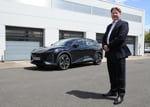It’s not easy being green,” lamented Kermit the frog.
Modern fleet managers, far from being Muppets, know better.
The incentives for going green, whether purely ethical or motivated by financial needs or concerns over corporate social responsibility, are growing.
The recent Budget upped the pressure on fleets to address their environmental impact, announcing greater Vehicle Excise Duty and reduced capital allowance breaks for the most polluting cars, due to come into force next year.
Managers of large fleets are becoming increasingly aware of the tax breaks and cost savings to be had from going green.
Cars with low CO2 emissions are more efficient, cutting fuel costs, and drivers benefit from graded Benefit-in-Kind taxation that rewards lower polluting vehicles.
Operators of smaller fleets, however, can encounter stone-faced finance directors and board members when trying to clean up their company’s cars.
“I don’t think any organisation can afford not to look at their CO2 output and fuel consumption,” says Tim Anderson, fleet advice manager at the Energy Saving Trust.
“The cost of fuel alone must make drivers and managers think about the vehicles they’re operating.”
“The starting point is to make senior management aware of the potential cost savings.”
Jug Johal, fleet manager of North Lincolnshire and Goole NHS Trust, agrees that the way to go green is through the company’s balance sheet.
“There are huge cost benefits to reducing your CO2,” he says. “But the key to seeing savings is having senior management support. If you haven’t got it, then you’re fighting a loosing battle.”
To help them on their way managers with 50 or more vehicles can opt for a green fleet review carried out by the Energy Saving Trust (EST).
For more bespoke advice on going green, those with smaller fleets can conduct a free telephone consultancy with the EST.
Tasked with cutting the mileage of his NHS Trust’s grey fleet, Jug Johal carried out an EST green fleet review.
After assessing the number of business miles racked up by employees (hundreds of thousands) one of the measures he introduced to get doctors, consultants and nurses out of their cars was a staff bus.
Since running the bus from September 2007 the hospital trust has saved £40,000.
Communal travel may not be the solution for smaller business fleets stocked with executive vehicles but Mr Johal’s experience is a good example of what can be achieved by getting to grips with company mileage.
Tim Anderson points out that cutting emissions and mileage does not have to mean a complete overhaul of the company fleet, or any cash injection at all.
“Traditionally, managers see implementing green initiatives as costing money, but it’s not necessarily going to cost money or new technology,” he says.
“For example, changing your policy so CO2 is capped, with no cars above 165g/km, wipes out a whole range of cars that are expensive to use.”
In light of Benefit-in-Kind and the Government’s agenda to start taxing company cars based on CO2, Alison Chapman, head of automotive tax at Deloitte, urges managers to consider tax when thinking about the wholelife cost of their vehicles.
“Companies need to bring tax into the calculation of wholelife costs – there are enormous differences between different emitting cars,” she says.
“Going green doesn’t have to mean taking on a load of hybrids – certain diesels out there have better residual values than so-called green cars.”
Nigel Trotman, business relationship manager at Whitbread, says going green does not have to mean capping CO2 or choosing hybrids but simply picking the right cars.
“Fleets need to focus on what’s practicable today,” he says. “Look at low-emitting conventional cars like the BMW 118d and the Audi A3. These are practicable and emit under 120g/km, also helping avoid the congestion charge.
“Understand the opportunities that are there by picking better cars with better fuel efficiency, lower tax and lower emissions,” adds Mr Trotman.
If company executives are adamant about the cars they want then fleet operators should still try and offset their emissions elsewhere, says Julie Boyd, business solutions manager at motor group Listers.
“If senior management won’t budge, look at other ways of reducing carbon emissions – offset within your fleet. Present the case on paper for offsetting with the rest of the company’s cars.
"Fleet managers are busy people and they could really do with making some quick wins by looking at the CO2 emissions of their vehicles.”
Managers should also remember that green travel management does not stop with the company’s cars.
Reducing mileage is good for the planet while cutting costs and can be achieved by incentivising staff to use public transport and, wherever possible, not travel at all.
“The business case for going green and implementing other forms of working, if you’re taking this to a finance director, is that you’re not just seeing savings on fuel but also in the efficiency of people,” says Tim Anderson.
“There are huge financial savings in having employees at their desk working, instead of in a traffic jam.”
Go green cut costs
Work out your fleet’s mileage and emissions – green fleet review.
Understand the make-up of your fleet – are there cars with similar specifications and lower emissions that can match your company’s needs and help cut costs?
Be aware of the tax benefits – both BIK and incoming company car tax – from choosing less polluting cars.
Explore travel alternatives – home working, tele-conferencing, public transport.
















Login to comment
Comments
No comments have been made yet.